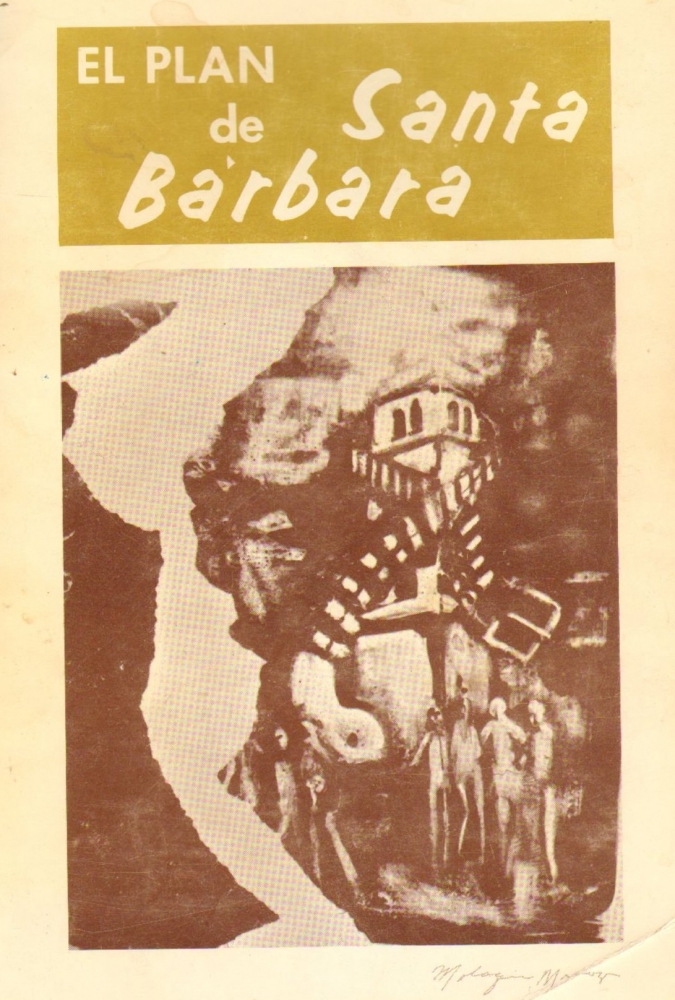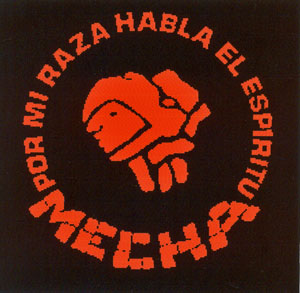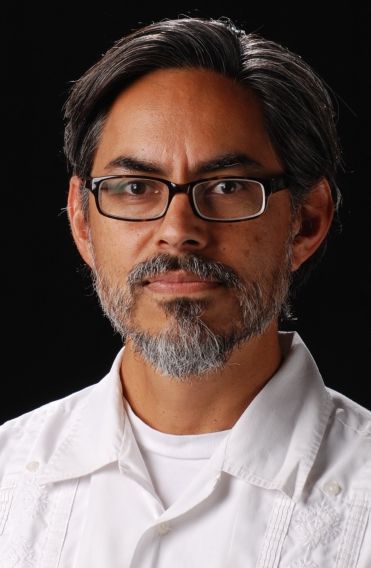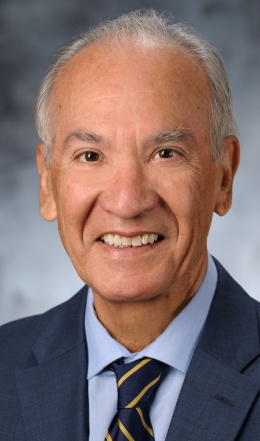
‘The Future is Here’
In the late 1960s, so few other Latinos attended his college, Cástulo de la Rocha could find and personally call them all in a matter of days. And as a student activist in a growing Chicano Movement, he did just that.
“There was an ongoing debate at the time whether there were 20 or 40 or 50 Latinos here at that time,” recalled de la Rocha, then a student at UC Santa Barbara. “So I went to all the students one by one, by last name — Gómez, González, Martínez — all of them. Our number was small. Today the university is very different. Of more than 20,000 students on campus close to 30 percent are Latino, which is extraordinary.”
UC Santa Barbara now is one of two Hispanic-Serving Institutions in the prestigious Association of American Universities, a designation stipulating that Hispanic students comprise at least 25 percent of total enrollment.
And de la Rocha, alongside other passionate, vocal students, staff and faculty, played an important role in that evolution. During a time of widespread unrest over the Vietnam War, the Civil Rights Movement and more, he was a key figure at UC Santa Barbara in the Chicano Movement that was also then burgeoning on campuses nationwide.
Among its core priorities was a push for higher education to better reflect Chicano identities in student populations — and better represent Chicano history and culture in curricula and scholarship. Scoring on both fronts, the movement in 1969 notched a now-landmark achievement: El Plan de Santa Bárbara.
Architects of change
Drafted by students, faculty and other delegates from across the UC system during a special conference at UC Santa Barbara in April 1969, El Plan was a 155-page manifesto and detailed blueprint for the formation of university-level Chicano Studies programs. It worked.
The conference became a higher-education catalyst for the movement at UC Santa Barbara, across California and beyond, and El Plan came to be seen as a seminal document resulting in the establishment of many Chicano/Chicana studies programs. In fact, UC Santa Barbara’s own program — now entering its 50th year — was launched within months of El Plan’s release.
Now, UC Santa Barbara will mark these milestones with a 50th anniversary conference examining the significance and enduring impact of El Plan. The Feb. 22-23 events, to be held in multiple venues on campus, are free and open to the public.
“What happened here 50 years ago is very significant in terms of the relationship of Chicanos and higher education,” said Mario García, a professor of Chicano/a studies and co-organizer of the anniversary conference. “It was groundbreaking, and that’s why the document is seminal. There are others, but in terms of higher education this is the document, the one that really laid the foundation. The original conference was crucial to establishment of Chicano studies, and it also helped to unify the student movement.”

An early logo for Movimiento Estudiantil Chicano de Aztlán (M.E.Ch.A.)
In fact, it gave the student movement its own name, merging then-prominent United Mexican-American Students (UMAS) and several smaller organizations into a singular force for change with a new moniker, Movimiento Estudiantil Chicano de Aztlán (M.E.Ch.A.). Today there are hundreds of MEChA chapters nationwide.
Among the anniversary conference highlights, a panel discussion moderated by de la Rocha will feature several other UC Santa Barbara alumni who played a role in El Plan.
“As we look at the last 50 years and what has happened in the state of California and on university campuses, on private and public campuses, it’s extraordinary to see the huge changes that have occurred,” said de la Rocha, president and chief executive officer of community health provider AltaMed, who will speak at an alumni reception during the anniversary event (and in October will be honored with UCSB’s Distinguished Alumni Award). “Quite frankly a lot of that — the roots of many of these changes — are directly tied to what we envisioned way back 50 years ago.”
A view of the future
That vision centered primarily on “what a more just and equal higher education system should look like, not only including us but also in the work that it did and who benefitted from it,” said alumnus Joel García, a UC Santa Barbara student in 1969 and contributor to El Plan.
“We began to ask the basic civil rights and human rights questions that needed to be asked, including why the education system wasn’t what it could be and should be for everybody,” recounted García. “We as Chicanos were clear that we grasped our identity and defined it for ourselves. We wanted our institutions to recognize that and be involved with it. We wanted our interests to be acknowledged and for something to be done about them. The resulting document was our collective view of what the future could and should be.”
And it was no pie in the sky. The delegates to the 1969 conference didn’t just want change — they were determined to affect it.
“At that time, I was committed to improving the lives of the Mexican-American community and to achieving that improvement largely through education,” said alumna Mariana Marin ’71, who helped to organize the landmark conference and draft El Plan. “We considered the push for educational opportunity to be a struggle that would help our community advance and that it was one of the paths that would lead to equality and justice. I was very proud of what we were doing. We did hope that the Plan would become a seminal document in establishing Chicano Studies.”
It did that and then some.
Forward progress
At UC Santa Barbara, for decades the only UC campus with a Chicano studies department, El Plan led also to the creation of the research-focused Center for Chicano Studies (now the Chicano Studies Institute) and Chicano EOP (Educational Opportunity Program) to help Chicano and Latino students transition to campus from their home communities. Yet another direct result: a Chicano/a studies collection, Colección Tloque Nahuaque, at UC Santa Barbara Library.
The effects continued to reverberate. In 2003 UC Santa Barbara became the first university in the nation to offer a Ph.D. in Chicano/a Studies.
Gerardo Aldana is a professor and current chair of the campus’s Department of Chicano/a Studies. Among his current courses is “CHST Unbound” — open to undergraduate and graduate students, majors and non-majors alike — which he describes as “a completely unstructured opportunity for students to develop their own plans for how we investigate whether El Plan has come to fruition or not.”
So, has it?

Gerardo Aldana
“The result in 1969 was a specific plan intended to create an academic pipeline into the university for underserved and underrepresented communities, along with a structure to hold that pipeline accountable to the communities it served,” said Aldana, co-organizer of the anniversary conference. “The growth of the Chicana/o/x, Latina/o/x population at UC Santa Barbara and its relatively new status as a Hispanic Serving Institution unequivocally represents one goal of El Plan attained. But that does not mean that the work is finished or that the whole objective has been met.
According to Aldana, the original conference from which El Plan arose was about students, staff and faculty coming together to address educational injustices. “It tackled the California Master Plan for Higher Education head-on,” he said. “That original policy document laid out a role for public education in a democratic society. Because the state government was intended to be representative and democratic, that meant that its actual population had to be taken into account and public education would have to change to address the needs of its diverse residents.
“The key issue then is still critical today,” Aldana added. “How does a democratic institution represent and empower its diverse and changing demographic constituents?”
Looking ahead
That additional work is yet to be done is a sentiment echoed across the board. Injustices and inequalities remain, said de la Rocha, with “poverty and hunger and unemployment and immigration still very real challenges to a substantial portion of the population.”
“Where we are today is way beyond what we hoped for in many ways, but at the same time there is so much more along the same lines that needs to be done, and maybe as much and as urgently today,” concurred Joel García. “Chicano studies can take the lead, take leadership in doing the things that make the difference, not just talking about them. And what I’m most proud of, is that the UCSB Chicano Studies department and resource center and students are dedicated to that.”
Indeed, they are, and their dedication is a direct outcropping of the undeniable momentum cultivated by el movimiento and El Plan de Santa Barbara, asserted Mario García.

Mario García
“In my opinion, the greatest contribution of the Chicano Movement, practically speaking, was the significant entrance of increased numbers of Chicano and other Latino students into higher education,” he said. “To me that’s the greatest success, and it continues. Could it be more? Yes, it should be. It needs to be more. But we have now reached HSI status, with Hispanic enrollment at 26 or 27 percent — a far cry from those 50 students that were here in the ’68-69 year. It’s a huge achievement.
“We have now, in this country, close to 60 million Latinos, almost 20 percent of the U.S. population, and demographers say that by 2050, 1 of 3 Americans will be Latino,” García noted. “I tell my students, ‘In California, we don’t have to wait until 2050. In California, the future is here.’”



